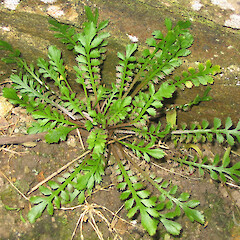Lepidium tenuicaule
Common name
shore cress
Synonyms
None
Family
Brassicaceae
Flora category
Vascular – Native
Endemic taxon
Yes
Endemic genus
No
Endemic family
No
Structural class
Herbs - Dicotyledons other than Composites
NVS code
The National Vegetation Survey (NVS) Databank is a physical archive and electronic databank containing records of over 94,000 vegetation survey plots - including data from over 19,000 permanent plots. NVS maintains a standard set of species code abbreviations that correspond to standard scientific plant names from the Ngä Tipu o Aotearoa - New Zealand Plants database.
LEPTEN
Current conservation status
The conservation status of all known New Zealand vascular plant taxa at the rank of species and below were reassessed in 2017 using the New Zealand Threat Classification System (NZTCS) – more information about this can be found on the NZTCS website. This report includes a statistical summary and brief notes on changes since 2012 and replaces all previous NZTCS lists for vascular plants.
Please note, threat classifications are often suggested by authors when publications fall between NZTCS assessment periods – an interim threat classification status has not been assessed by the NZTCS panel.
- Conservation status of New Zealand indigenous vascular plants, 2017 . 2018. Peter J. de Lange, Jeremy R. Rolfe, John W. Barkla, Shannel P. Courtney, Paul D. Champion, Leon R. Perrie, Sarah M. Beadel, Kerry A. Ford, Ilse Breitwieser, Ines Schönberger, Rowan Hindmarsh-Walls, Peter B. Heenan and Kate Ladley. Department of Conservation. Source: NZTCS and licensed by DOC for reuse under the Creative Commons Attribution 4.0 International licence.
2017 | At Risk – Declining | Qualifiers: DP, RR
Previous conservation statuses
2012 | At Risk – Declining | Qualifiers: RR
2009 | At Risk – Declining
2004 | Gradual Decline
Distribution
Endemic to the North and South Islands. In the North Island probably extinct, having been recorded only from Kapiti Island. In the South Island known from Oamaru south to the islands of the Foveaux Strait.
Habitat
Coastal turf where it seems to prefer damp peaty ground free from taller shrub and grass species. Very tolerant of shade and trampling such that some large populations are known from seaside car parks, footpaths, walking tracks and around lighthouse buildings. At one time this species was even a localised urban weed at Oamaru.
Detailed description
Rosette forming, perennial herb, arising from stout, deeply descending taproot. All parts pungent, smelling strongly of cress. Stems prostrate to ascending, glabrous (20-)80-150(-300) mm long. Leaves glabrous or glabrescent. Basal leaves persistent, pinnate, 20-100 x 0.5-0.15 mm, dark green, basally mottled with red or purple. Pinnae in (5-)7-15 pairs, acutely toothed. Stem leaves toothed at apex or entire, 5-20 x 2-5 mm, green, narrow-spathulate, linear-oblanceolate, long petiolate. Racemes 50-100 mm long at fruiting, somewhat flexuous, rachis and pedicels glabrous or sparsely hairy, pedicels distant, spreading, 2-4 mm long at fruiting. Sepals sparsely hairy, 0.5-1 x 0.3-0.5 mm. Petals 0 or if present white, < sepals. Stamens 4. silicles suborbicular, 1.5-2 x 1.5-1.8 mm, style 0.1 mm, free from narrow wing, = to or > than shallow notch, valves glabrous. Seed ovoid, brown c. 1 mm long.
Similar taxa
Very distinctive and unlikely to be confused with any other species of lepidia. When sterile the rosette leaves have a remarkable resemblance to some species of Leptinella, from which they can be distinguished by their pungent cress smell when they are bruised.
Flowering
October - January
Flower colours
White
Fruiting
November - February
Life cycle
Mucilaginous seeds are dispersed by attachment and possibly wind and water (Thorsen et al., 2009).
Propagation technique
Easy from fresh seed. With its multi-coloured ferny rosette leaves, and compact habit this is the ideal plant for places with compacted, poorly drained and otherwise bare soil, such as driveways, shaded portions of poorly drained lawns, and along the bases of brick walls.
Threats
Probably more secure than was once believed, although it does seem to have gone extinct from the North Island, Oamaru and at nearby Cape Whanbrow. Very large populations occur from about Shag Point south along the Foveaux Strait. However, some of these have been lost due to changes in habitat caused by the removal of car parks and roads that cross coastal turfs to access coastal locations. With one or two exceptions the species remains vulnerable to any change in local disturbance regimes, particularly those which encourage the growth of taller shrubs and grasses.
Etymology
lepidium: Scale-shaped (pods)
tenuicaule: Thin-stemmed
Where To Buy
Occasionally available from some specialist native plant nurseries.
Attribution
Fact sheet prepared by P.J. de Lange for NZPCN (1 June 2013)
References and further reading
Thorsen, M. J.; Dickinson, K. J. M.; Seddon, P. J. 2009. Seed dispersal systems in the New Zealand flora. Perspectives in Plant Ecology, Evolution and Systematics 11: 285-309
NZPCN Fact Sheet citation
Please cite as: de Lange, P.J. (Year at time of access): Lepidium tenuicaule Fact Sheet (content continuously updated). New Zealand Plant Conservation Network. https://www.nzpcn.org.nz/flora/species/lepidium-tenuicaule/ (Date website was queried)





